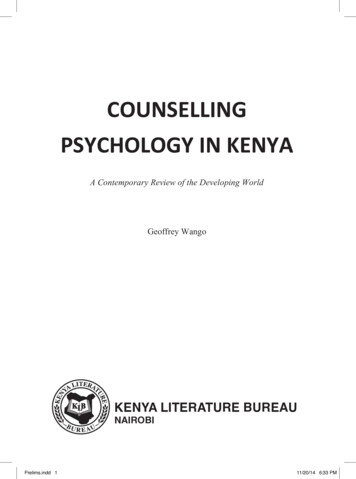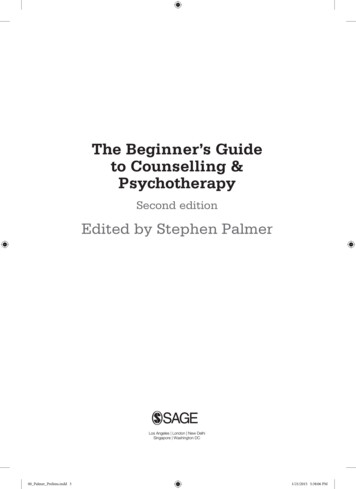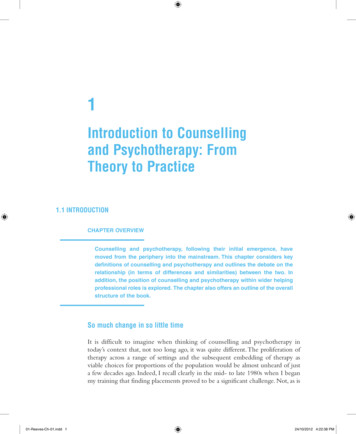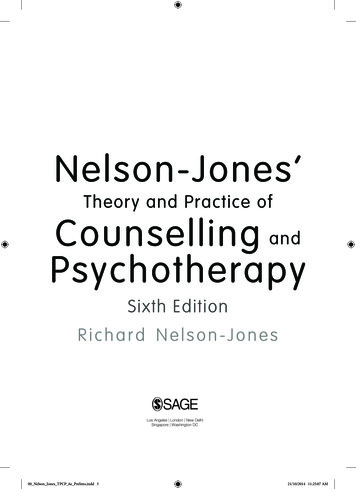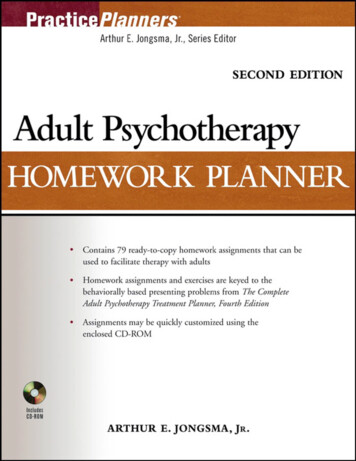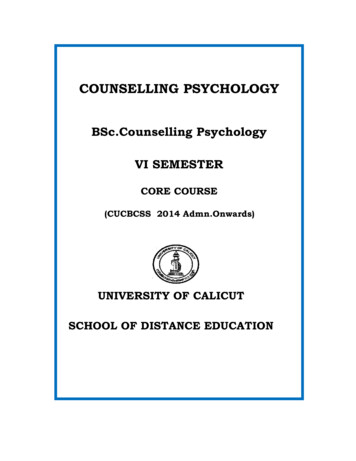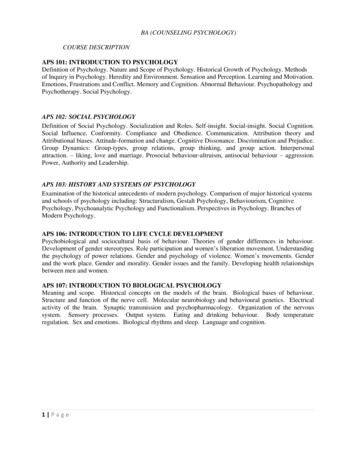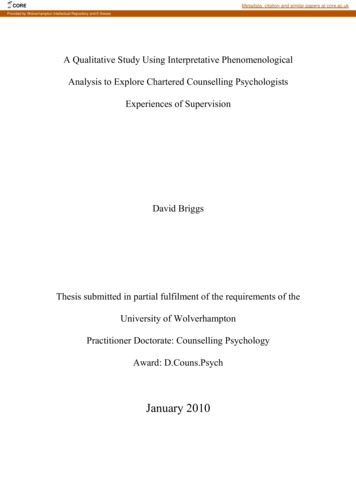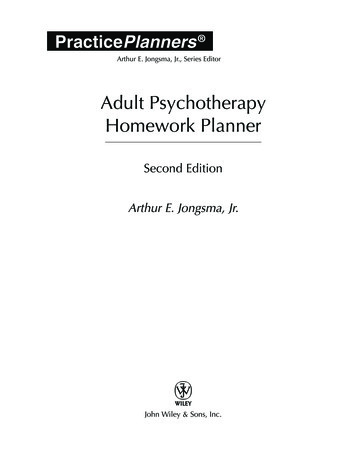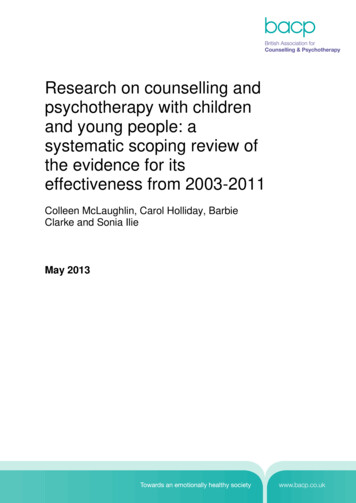
Transcription
Research on counselling andpsychotherapy with childrenand young people: asystematic scoping review ofthe evidence for itseffectiveness from 2003-2011Colleen McLaughlin, Carol Holliday, BarbieClarke and Sonia IlieMay 2013
Research on counselling and psychotherapy with children and young people: a systematic scopingreview of the evidence for its effectiveness from 2003 – 2011 is published by the British Association forCounselling & Psychotherapy, BACP House, 15 St John’s Business Park, Lutterworth, Leicestershire,LE17 4HB.t: 01455 883300f: 01455 550243e: bacp@bacp.co.ukw: www.bacp.co.ukBACP is the largest professional organisation for counselling and psychotherapy in the UK, is acompany limited by guarantee 2175320 in England and Wales, and a registered charity, 298361. British Association for Counselling & Psychotherapy 2013Correspondence to:Carol HollidayAffiliated lecturer, Faculty of Education, University of Cambridge, 184 Hills Road, Cambridge CB2 8PQe: cah66@cam.ac.ukColleen McLaughlinProfessor of Education, Faculty of Education, University of Cambridge at the time of writing and now ofthe Department of Education, University of Sussex, Falmer, Brighton, BN1 9QQ, UKe: C.M.McLaughlin@sussex.ac.ukDr Barbie ClarkeAssociate Researcher, Faculty of Education, University of Cambridge, 184 Hills Road, Cambridge,CB2 8PQe: Bhc24@cam.ac.ukSonia IliePhD Candidate, Faculty of Education, University of Cambridge, 184 Hills Road, Cambridge CB2 8PQe: isi22@cam.ac.ukAcknowledgementsThe authors would like to thank wholeheartedly the following people and organisations: BACP for funding this reviewLyndsay Upex for her meticulous and invaluable work at every stagePeter Bowers for his supervision and supportJulia Macpherson for her support and work during this processMartyn Richards for the work on the searchOur partners for their patience and supportThis publication is protected under copyright under the Berne Convention and the UniversalCopyright Convention. All rights reserved. No part of this publication may be produced ortransmitted in any form or by any means, including photocopying, microfilming, andrecording, without the written permission of the copyright holder, application for which shouldbe addressed to the Chief Executive at BACP. Such written permission must always beobtained before any part of this publication is stored in a retrieval system of any nature, orelectronically. BACP 2013Research on counselling and psychotherapy with children and young people1
ContentsExecutive summary . 3Introduction . 7Methodology . 11Findings . 16Methodological reflections . 76Conclusions and implications . 80Appendices . 822Research on counselling and psychotherapy with children and young people BACP 2013
Executive summaryObjectivesTherapeutic work with children and young people is receiving more resources and attention in the UK,as shown in the recent development of a national strategy for school-based counselling in Wales(Pattison et al, 2007). This arises from recognition of the mental health needs of children and youngpeople. In 2004, BACP published a review of the effectiveness of therapeutic interventions withchildren and young people (Harris and Pattison, 2004). This study updates that review and seeks toanswer the same questions. In addressing the overall question – Is counselling and psychotherapyeffective for children and young people? – three sub questions were identified:1. Which types of counselling and psychotherapy interventions work?2. For which presenting problems?3. For whom?These questions informed the 2004 review and this update.The nature of the reviewThe 2004 review was informed by the BACP definition of counselling at the time of publication, that:“Counselling takes place when a counsellor sees a client in a private and confidential setting toexplore a difficulty the client is having, distress they may be experiencing or perhaps theirdissatisfaction with life, or loss of a sense of direction and purpose. It is always at the request ofthe client as no one can properly be ‘sent’ for counselling.” (Harris and Pattison, 2004)This study takes on board the updated (2012) BACP definition of counselling, particularly in relation tocounselling in schools: “Counselling and psychotherapy are umbrella terms that cover a range of talking therapies.They are delivered by trained practitioners who work with people over a short or long term tohelp them bring about effective change or enhance their wellbeing.Counselling can be an effective early intervention strategy for children and young people whohave emotional, behavioural or social difficulties, with the aim of alleviating, lessening orpreventing these problems from becoming more complex, costly and requiring referral tospecialist services.School-based counselling is a professional activity delivered by qualified practitioners inschools. Counsellors offer troubled and/or distressed children and young people anopportunity to talk about their difficulties, within a relationship of agreed confidentiality.”Scoping study: definition of termsThis study is a systematic scoping review, whose aim is to map rapidly the key concepts underpinningthe research area and the main sources and types of evidence available. Statistical methods were notused, nor were the studies in meta-analyses reanalysed. Instead a narrative approach was adopted todescribe the extent and nature of the literature. Systematic methods were used to review theevidence, as described in the methodology section. Judgements about the quality of studies weremade when deciding which should be included in the review and the quality of included studies wasalso appraised and reported on. Two broad categories of study were included in the review: newstudies published since 2003 and systematic reviews published post-2003, which may have includedpre-2003 studies.The nature of the evidenceStudies that fell into any of the following domains, as categorised in the 2004 review, were included inthe update:1. The evidence from systematic reviews and meta-analyses.2. The evidence from controlled trials, including randomised control trials (RCTs) and controlledbefore and after studies (CBAs) that did not use randomisation.3. Supporting evidence from cohort studies, case studies, observational and exploratory studies,and methodological papers that raise issues for future research in this field. BACP 2013Research on counselling and psychotherapy with children and young people3
Review methods Bibliographic databases searched using CSA Illumina, which provides access to more than100 databases 517 papers identified through Illumina 513 records identified after duplicates removed 317 excluded after screening 196 records further screened and 53 excluded after reading abstracts 143 full text articles assessed for eligibility 41 excluded 102 full text articles included in the review Additional 12 papers identified through other sources 114 included in the final synthesisFindingsWhich types of interventions work?Cognitive behavioural therapyCognitive behavioural therapies (CBT) were found to be effective for anxiety and behavioural andconduct problems. There is less evidence of the effectiveness of CBT for children as opposed toadolescents, and for depression as opposed to anxiety. More studies investigated CBT than any othertherapeutic intervention (36 per cent of total interventions). There is a need for further research toinvestigate the long-term effects of CBT interventions and to explore differential responses to CBT inchildren and adolescents with anxiety and depression.Psychodynamic therapyUnlike CBT studies, which have been carried out predominantly in the US, studies usingpsychodynamic therapies have a much wider geographical spread. Psychodynamic interventions areeffective for a variety of presenting problems, including mood disorders such as depression. There is asmall amount of evidence to support the construct of a ‘sleeper effect’ for psychodynamic therapy,which refers to how symptomatic recovery can be greater at six-month follow-up than at the end oftherapy. There is a need for further research in this area.Play therapyThe number of studies investigating play therapy has grown from just two in the 2004 review to 14 inthis update. One of these is a systematic review of 93 studies, marking the growth in the evidencebase for this type of therapy. As a therapeutic intervention, play therapy is highly effective for a varietyof presenting problems, particularly anxiety and behaviour/conduct problems; for a range of youngpopulations, but particularly primary-aged children; and in a number of settings, particularly clinics andschools.Humanistic therapies and interpersonal psychotherapyAs evidenced by a number of studies, humanistic therapies are effective in school settings.Interpersonal psychotherapy (IPT) was found to be beneficial for children and adolescents withdepression, particularly when presenting problems involved relational issues rooted in conflict.Non-specific factorsBeyond specific therapeutic approaches certain therapist behaviours and practices were found to beassociated with outcome. Therapists’ behaviour in the first stages of treatment was associated withyoung people’s subsequent engagement in their therapy. Other factors positively associated withoutcomes were paying attention to the client’s level of motivation, less structuring of the therapy andpaying attention to the young person’s experiences. Therapists’ selection of an appropriate treatmentstrategy was also important, along with offering choice to clients and being sensitive to gender andcultural issues.4Research on counselling and psychotherapy with children and young people BACP 2013
For which types of problems?DepressionIn the case of depression, psychological therapy was generally found to be beneficial and moreeffective than either no treatment or treatment as usual. A range of therapeutic approaches emergedas effective in the treatment of adolescent depression, including CBT, IPT, psychodynamic and familytherapies. Treatments were effective in the short term (up to six months) and there was littlediscernible difference in outcomes between therapeutic approaches.AnxietyAs in the 2004 review, CBT emerged as an effective therapy for anxious children and adolescents.Little evidence was found for the effectiveness of other approaches in the treatment of this problem.Since 2004, the amount of research in this area has grown steadily, providing a more detailedunderstanding of the active processes involved in CBT interventions. Evidence has also beenaccumulating for the effectiveness of IPT in reducing anxiety in young people who are also sufferingfrom depression.Post-traumatic stress disorderMost of the therapeutic interventions for PTSD involved short-term CBT-based therapies (including reexposure interventions, psycho-education, Emotion Recognition and Expression, or Eye MovementDesensitization and Reprocessing (EMDR). Parental involvement in the therapy was important for thesuccess of CBT interventions, with the exception of cases where there were especially negative familycircumstances or where parents may be perpetrators of abuse.Behaviour and conduct disordersSimilar to the 2004 review, the majority of studies investigating behaviour and conduct disordersemployed CBT interventions that were found to be effective. Conduct disorders were sometimesassociated with PTSD. Other effective interventions included Behavioural Parent Training (BPT) forboth pre-school and school-aged children, which was less effective with adolescents than withyounger children. More generic work with parents to help young people with conduct disorders alsohad evidence of effectiveness. Some interventions had detrimental effects where following theintervention, levels of antisocial behaviour actually increased. Such programmes, based on a ‘gettough’ approach, were not appropriate for the developmental stage of the child and ignored thepowerful influences of the psychosocial context (eg peer pressure).Learning difficulties and school-related problemsCounselling interventions are reasonably well established in UK and US schools, although defineddifferently in the two countries. A dearth of research into the counselling of children with learningdifficulties persists. The small amount of research available suggests that treating learning difficultiesand school-related problems in school settings may have some advantages over treatment in mentalhealth clinics. Additionally, a comparative study found humanistic therapy more effective than CBT forchildren with learning difficulties.Children affected by medical conditionsThere is a lack of evidence relating to psychological therapy for children affected by medical conditionsor for children with parents experiencing serious health issues. More research is needed in this area.Self-harmMore research is also needed in relation to self-harm in children and young people. The currentevidence is inconclusive, and this has consistently been identified by reviews and by a nationalenquiry as an under-researched area.Children and young people with eating disordersThere is a stronger evidence base regarding interventions for young people with eating disorders.Family therapy and CBT, including guided self-care, exhibited the most positive results. Othertherapies, including IPT, yielded more modest improvements in depressive symptoms and eatingbehaviours in the treatment of bulimia nervosa. In the case of anorexia nervosa, the importance of anempathic engagement and a therapeutic relationship that can be maintained over time, wereemphasised. Further research into the effectiveness of psychological therapies for people with eatingdisorders is recommended.Neglect and physical, emotional and sexual abuseFew studies looked into the effectiveness of counselling specifically for abuse. Within these studies,results pointed towards group treatment being generally beneficial for young people, as it normalisedtheir experiences, with the exception of children with poor social skills who ran the risk of further BACP 2013Research on counselling and psychotherapy with children and young people5
rejection. Re-traumatisation in therapy was a risk for children suffering from PTSD. This tended to beavoided by allowing the child a greater sense of control in the session. As discussed above (PTSDsection), parental participation only presented benefits when the family was not part of the problemcausing circumstances.For whom?Key factors that moderate the effectiveness of therapeutic approaches in the treatment of children andyoung people, across a range of problems, were race, gender, ethnicity, the child-therapist alliance,and parental involvement. All had an impact on the outcomes of specific interventions. Race andgender matching impacted on client retention and motivation, especially among particular ethnicgroups. The need for therapists to be trained to work with difference and diversity was highlighted.Studies indicated that the child-therapist alliance was an important factor but not as significant as theintervention itself and the child’s adherence to treatment. Parental involvement was generallybeneficial in work with younger children, particularly in the case of play therapy. However, the benefitswere less evident with CBT interventions.Implications for practice and further researchFuture research needs to be rigorous and transparent, and capture the complexity of routine practicewith this client group. To address this, a wider range of research methodologies is recommended.Attention also needs to be paid to the transfer of research findings into clinical settings to ensure thebest outcomes for clients. There is a need for research to address the relationship between age andtreatment outcome. This should focus on how treatment approaches can be adapted to the differentdevelopmental stages of adolescence and preadolescence. Additionally, research into the long-termimpact of interventions with children and young people is recommended. The relative absence ofresearch relating to certain disorders is noteworthy, particularly self-harm and eating disorders, andfurther research is needed in these areas.Methodological issuesMethodological discussions were evident in a number of papers included in the review, with particularreference to the evidence-based practice model. Questions regarding the generalisation ofexperimental research findings to routine practice settings are raised, along with the difficulty oftransferring treatments delivered in controlled experiments into routine practice. Likewise, the need tostudy therapy in routine practice while maintaining methodological rigour is highlighted. More researchcomparing therapies with usual care (as opposed to no treatment) is recommended, along with theneed for improved study designs and richer, more detailed, descriptions of interventions.6Research on counselling and psychotherapy with children and young people BACP 2013
IntroductionThis systematic scoping review was commissioned by BACP to contribute to the evidence base forcounselling and psychotherapy with children and young people. The review aims to be readable andrigorous, to inform practice, and to reconsider the evidence. It updates the Harris and Pattison (2004)review which asked: Is counselling and psychotherapy effective for children and young people? Thatwork aimed to provide a transparent, replicable and comprehensive review of the research evidenceinto the effects of counselling and psychotherapy for children and young people, and this reviewshares that aim. The original review together with this update gives an overview of research between1980 and early 2011. Both aim to identify the effects of interventions and draw out implications forpolicy and practice, as well as evaluating methodological issues and identifying priorities for futureresearch.Nature of the reviewThe review takes a systematic approach to the process of reviewing the literature on counselling andpsychotherapy with children and young people. Details of the review process are in Section 3,Methodology. Because this was an update, the processes used in the 2004 study were mirrored. Thishad strengths and limitations, but made it possible to see how the field has developed. Similardefinitions have been used in this update as in the original review. The 2004 Harris and Pattisonreview drew on the BACP definition of counselling:“Counselling takes place when a counsellor sees a client in a private and confidential setting toexplore a difficulty the client is having, distress they may be experiencing or perhaps theirdissatisfaction with life, or loss of a sense of direction and purpose. It is always at the request ofthe client as no one can properly be ‘sent’ for counselling.” (Harris and Pattison, 2004)This definition is a broad one, largely applicable to work with adults. The situation is different forchildren and young people, as they are often referred by adults rather than self-referring, and this hasbeen acknowledged in this review.This study takes on board the updated (2012) BACP definition of counselling, particularly in relation tocounselling in schools: “Counselling and psychotherapy are umbrella terms that cover a range of talking therapies.They are delivered by trained practitioners who work with people over a short or long term tohelp them bring about effective change or enhance their wellbeing. Counselling can be an effective early intervention strategy for children and young people whohave emotional, behavioural or social difficulties, with the aim of alleviating, lessening orpreventing these problems from becoming more complex, costly and requiring referral tospecialist services. School-based counselling is a professional activity delivered by qualified practitioners inschools. Counsellors offer troubled and/or distressed children and young people anopportunity to talk about their difficulties, within a relationship of agreed confidentiality.”A recent report on counselling in Wales (Philips and Smith, 2011) differentiates between the use ofcounselling and psychotherapy with children and young people, and the application of counsellingskills; this review focuses on the former and excludes the latter. The original 2004 review argued thatthere is little to differentiate counselling from psychotherapy and that they are part of a continuum. Weheld to this definition.In addressing the overall question – Is counselling and psychotherapy effective for children and youngpeople? – three sub questions were identified:1. Which types of counselling and psychotherapy interventions work?2. For which presenting problems?3. For whom?Which types of counselling and psychotherapy intervention work?The original categorisation of four groups of counselling and psychotherapy approaches was adopted:cognitive behavioural; psychoanalytic; humanistic and interpersonal psychotherapy (IPT); andplay/creative therapies. We recognise that humanistic and IPT are very different forms of practice.However, due to the relatively small amount of research into these two therapies, they were combinedas a matter of convenience. Table 1 shows the number of studies examining the various interventions. BACP 2013Research on counselling and psychotherapy with children and young people7
Table 1: Therapeutic interventions reviewedInterventionCBTHumanistic therapies and IPTPlay/creative therapiesPsychodynamic therapiesOther (inc. EBT1 not otherwise classified)2TotalFrequency49101910501383When interpreting the findings of this review it is important to bear in mind that no evidence ofeffectiveness is not the same as evidence of ineffectiveness, and that therapeutic approaches otherthan those reviewed here may in future prove effective.For which presenting problems?Evidence on the effectiveness of particular approaches is considered in relation to particularpresenting problems (see Table 2).Table 2: Presenting problems in reviewed literaturePresenting related issuesLearning difficulties57Eating disordersMedical conditions83Behaviour and conduct issuesSelf-harm101Abuse5Other (the term counselling/psychotherapy is used but the problem isunspecified)27Total112For whom?The effectiveness of interventions for particular groups was also examined in the review. In particular,issues of age, race, ethnicity, and groups with learning difficulties formed part of the analysis. Theimportance of developmental issues when working with children and young people was alsoexamined.ChallengesThere were several challenges in conducting this update. First, the large number of papers included inthe review made significant demands on resources. Second, resource limitations meant that only alimited grey search was undertaken. Authors adopted a flexible and inclusive approach to hierarchy ofevidence, including both quantitative and qualitative studies. This produced challenges in synthesisingthe data. Third, participant ages were not always clear from the studies, making it difficult to definewhether they were focused on children and young people.1 EBT evidence-based treatment/therapy2 Studies that evaluate a number of therapies are only counted once, in the ‘Other’ therapies class to avoid assigning disproportionate weight to thesetherapies in the evidence synthesis3 The 112 included papers covered a total of 138 interventions8Research on counselling and psychotherapy with children and young people BACP 2013
The original 2004 study did not include family or filial therapy but acknowledged this was a contentiousissue. This update includes family and filial therapy where it was part of a comparative study. Theupdate also investigated the involvement of parents and carers in therapy but ‘family therapy’ was notused as a search term. The 2004 review noted that psycho-educational approaches and peerinvolvement in therapy, including peer counselling, were significant areas not included in the review.The update is consistent with this approach, although in some cases psycho-education has beenincluded as part of the CBT literature.Overview of the reviewed papersAn overview of the included papers is presented here with a more detailed analysis in subsequentsections of the report. The distribution of approaches, types of presenting problems, and types ofstudy are shown in Figures 1, 2 and 3.Figure 1: Therapeutic approaches in reviewed literature BACP 2013Research on counselling and psychotherapy with children and young people9
Figure 2: Types of study in reviewed literatureFigure 3: Main presenting problems in reviewed literature10Research on counselling and psychotherapy with children and young people BACP 2013
MethodologyThis section details the general approach taken in the review, search methods, the inclusion andexclusion criteria, and the three-stage process of excluding papers. The lists of included and excludedpapers are included in Appendix 1.Scoping study: definition of termsThis study is a systematic scoping review. Arksey and O’Malley (2005) observe that definitions ofscoping studies are few and far between, noting that scoping studies “aim to map rapidly the keyconcepts underpinning a research area and the main sources and types of evidence available” (Mayset al, 2001). The NHS Centre for Reviews and Dissemination (2001) defines a systematic review as:“A review of the evidence of clearly formulated questions that uses systematic and explicitmethods to identify, select and critically appraise relevant primary research, and to extract andanalyse data from the studies that are included in the review. Statistical methods (meta-analysis)may or may not be used.”In this scoping study statistical methods were not used nor were the studies included in systematicreviews reanalysed. However, systematic methods were used to review the evidence. Judgementsabout the quality of studies were made when deciding which should be included in the review and thequality of included studies was also appraised and reported on. This is discussed further in sections3.3 and 3.4 below. A three-stage process of searching and excluding studies was used, as shown inFigure 4, and is discussed below. This update of the 2004 review searched for studies publishedbetween 2003 and 2011, creating two broad categories: new studies published since 2003; andsystematic reviews including numerous studies, some of which may have been published before 2003. BACP 2013Research on counselling and psychotherapy with children and young people11
Figure 4: Search and identification process517 records identified through database (Illumina)Identificationsearches513 records identified after duplicates removed513 records screened317 records excluded196 records further screened53 records excluded after readingScreeningabstracts41 full-text articles excluded:143 full-text articles assessed foreligibility12Not research papers: general, theoretical discussions, editorials7Did not involve therapyDiscussed issues not part of the original reviewInvolved medication as comparison102 full-text articles included in final4Did not involve childrenreview2Evidence prior to 20031Measured effectiveness of therapists’ training1Collected young people’s views of school counsellingEligibility6528 studies identified through other1Did not adhere to methodological standards1Involved family therapy only1Evaluated services not about counselling18 full-text articles further excluded:Includedsources and additional searches128Involved medication as a comparison4Did no focus on therapy or effectiveness2Not research paper: general, correction1Discussed predictors of suicidal behaviour, not therapy112 studies included in the finalrevieweffectiveness1Did not involve children or therapists1No clear relevant conclusions1Therapy not carried out by professionalsResearch on counselling and psychotherapy with children and young people BACP 2013
Search strategyThe same search strategy as used in the original 2004 study was used in this update. This wasimportant in order to maintain consistency with the original report, but means that inevitably someareas of evidence may have been left out.The initial list of search terms related to: the child and adolescent population, ie child, adolescent, youth, children adolescence andyoung people counselling and psychotherapy counselling, ie counselling, psychotherapy, therapy andchildren terms for outcomes and effectiveness, ie reviews, meta-reviews, effectiveness andoutcomes.This screening was carried out using record titles and abstracts (where available) to ensure the searchresults conformed to the search parameters and was relevant for answering the scoping studyquestions.Bibliographic databases were searched. CSA Illumina was used, providing access to more than 100databases including: ComDisDome, IBSS (International Bibliography of the Social Sciences), CSASocial Services Abs
therapy. There is a need for further research in this area. Play therapy The number of studies investigating play therapy has grown from just two in the 2004 review to 14 in this update. One of
